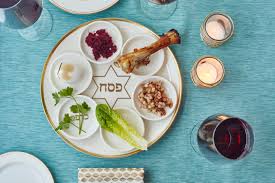
Three Matzot are placed on top of each other on a plate or napkin and then covered.
The Matzot are symbolic of the three casts of Jews: Priests, Levites and Israelites. They also commemorate the three measures of fine flour that Abraham told Sarah to bake into Matzah when they were visited by the three angels.
On a practical level, three Matzot are needed so that when we break the middle Matzah, we are still left with two whole ones to pronounce the Hamotzi (as required on Shabbat and Holidays).
On a cloth or plate placed above the three Matzot we place the following items:
- The Shank Bone
A piece of roasted meat represents the lamb that was the special Paschal Sacrifice on the eve of the exodus from Egypt. The Paschal Sacrifice was brought in the afternoon before Passover in the time of the Holy Temple.
Preparation: Roast neck on all sides over an open fire on the stove. Afterwards, some have the custom to remove for the majority of the meat of the neck.
Role in the Seder: The shank bone is not eaten. After the meal it is refrigerated and used a second time on the Seder plate the following night.
- The Egg
A hard boiled egg represents the Holiday Offering in the days of the Holy Temple. The meat of this animal constituted the main part of the Passover meal.
Preparation: Boil one egg per Seder plate and possibly more for use during the meal.
Role in the Seder: Place one egg on each plate. As soon as the actual meal is about to begin, remove the egg from the Seder plate and use during the meal.
A popular way of eating these eggs is to chop and mix them with the salt water which was set on the table. The eggs prepared this way are then served as an appetizer before the fish.
- The Bitter Herbs
Bitter herbs remind us of the bitterness of the slavery of our forefathers in Egypt. Fresh horseradish, romaine lettuce and endive are the most common choices.
The greens must be washed extremely well before the Holiday begins and care must be taken to check for insects. Afterwards, they are dried very well.
Preparation: This must be done before the Holiday begins. Peel the raw horseradish roots and rinse them off well.
Note: Dry the roots very carefully, since they will be eaten with the matzah later on for the "matzah and maror sandwich" and not even a drop of water should be left on the horseradish, to avoid gebrokts.
Next, grate the horseradish with a hand grater or electric grinder.
NOTE: Whoever will be grating the horseradish will begin to shed copious tears or cough a lot. Covering the face with a cloth from the eyes downwards helps prevent inhalation of the strong, bitter odor.
The marror is placed on the Seder plate on top of a few cleaned, dried leaves of romaine lettuce (which is also maror).
Role in the Seder: After the recital of most of the Haggadah comes the ritual hand washing. Then matzah is eaten followed by some marror folded in one or two romaine lettuce leaves, followed in turn by a sandwich of matzah, marror, and romaine lettuce leaves.
- The Paste
A mixture of apples, nuts and wine which resembles the mortar and brick made by the Jews when they toiled for Pharaoh.
Preparation: Peel walnuts and apples and chop finely. Mix together and add a small amount of wine.
Role in the Seder: This is used as a type of relish into which the marror is dipped (and then shaken off) before eating.
- The Vegetable
A non-bitter root vegetable alludes to the back-breaking work of the Jews as slaves. The Hebrew letters of karpas can be arranged to spell "Perach Samech".
Perach means backbreaking work and Samech is numerically equivalent to 60, referring to the 60 myriads (10,000), equaling 600,000, which was the number of Jewish males over 20 years of age who were enslaved in Egypt.
Preparation: Peel an onion or boiled potato. Cut off a slice and place on Seder plate. On the table, next to the Seder plate, place a small bowl of salted water.
Role in the Seder: After recital of Kiddush, the family goes to the sink and ritually washes hands, but without saying the usual blessing.
Then the head of the household cuts a small piece of the root vegetable used, dips it in salt water, and gives each person at the table a very small piece over which they say the appropriate blessing. Care should be taken that each person eats less than 17 grams ( 1/2 ounce).
- The Lettuce
The lettuce symbolizes the bitter enslavement of our fathers in Egypt. The leaves of Romaine lettuce are not bitter, but the stem, when left to grow in the ground, turns hard and bitter.So it was with our enslavement in Egypt. At first the deceitful approach of Pharoah was soft and sensible and the work was done voluntarily and even for pay. Gradually, it evolved into forced and cruel labor.Preparation: Romaine lettuce is often very sandy. Wash each of the leaves separately, checking very carefully for insects. (Pat gently with a towel and let sit until completely dry, so that there will be no moisture to come in contact with the matzah.)Depending on how much romaine lettuce is needed, it can take several hours to prepare. This task should be completed before candle lighting time on the first night. Prepare enough leaves for both nights and store in the refrigerator. Soaking of the Romaine leaves may not be done on the Holiday.Role in the Seder: the Lettuce is used in conjunction with horseradish. It is used when eating the marror and when eating the matzoh and maror sandwich.Place the leaves in two piles on the Seder plate, one under the maror and one separately at the bottom.Keep a stack of extra cleaned leaves handy in the refrigerator in case additional leaves are needed.
The special foods we eat on Passover are also food for thought. Every item on the Seder plate abounds in meaning and allusion. Following are a description of each of the Seder plate foods listed above with the reason each is included, the method of preparing it, and its role in the Seder meal.
